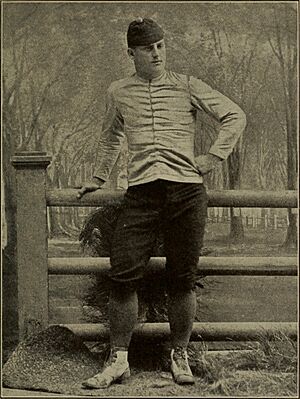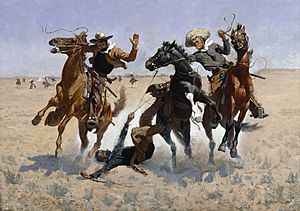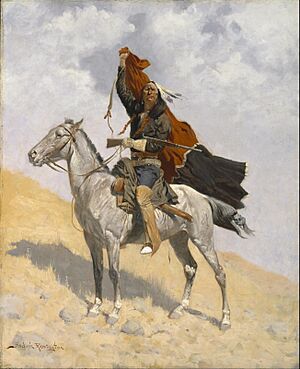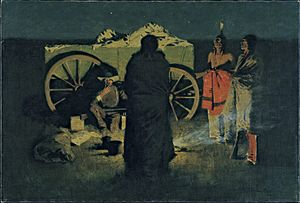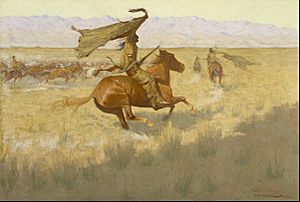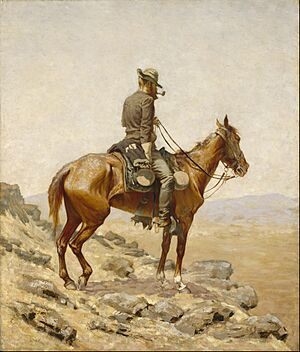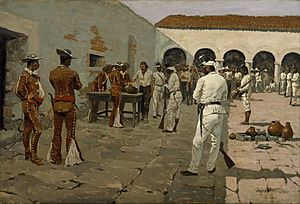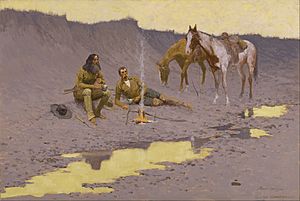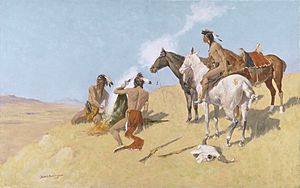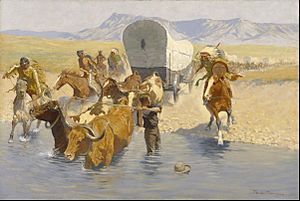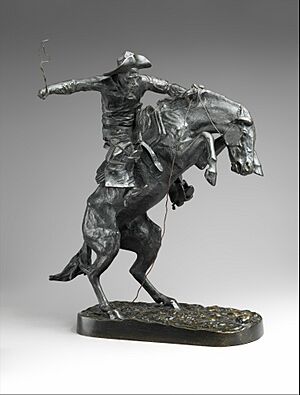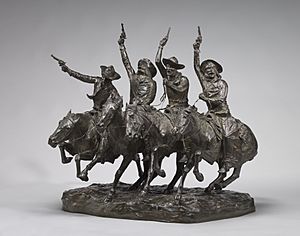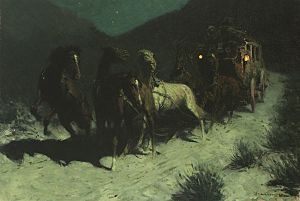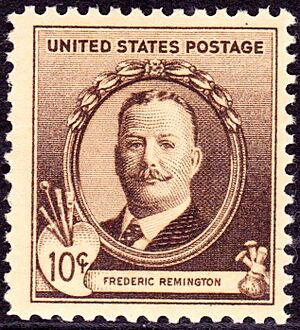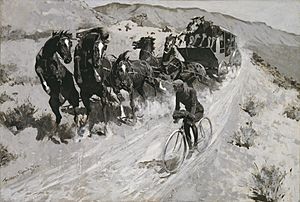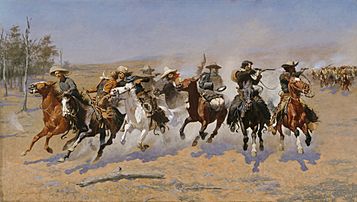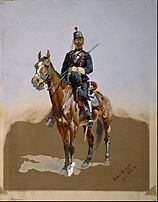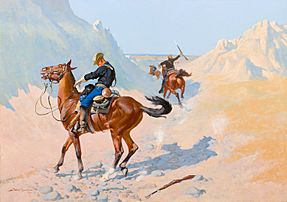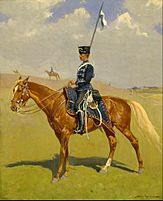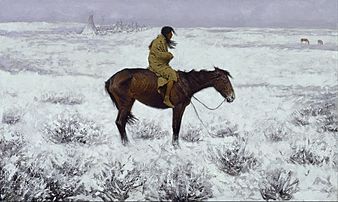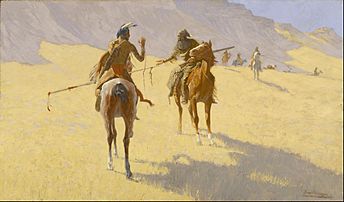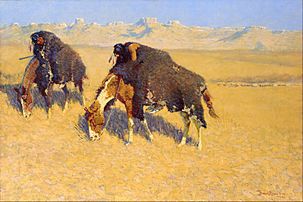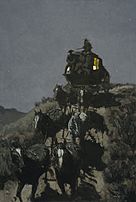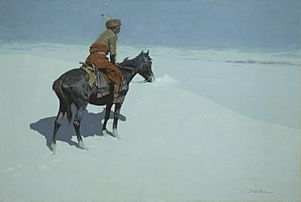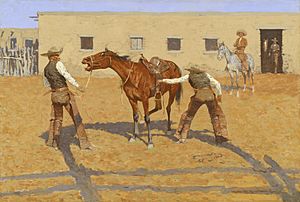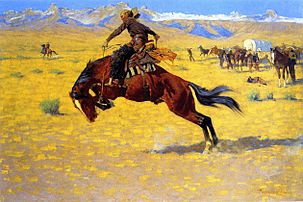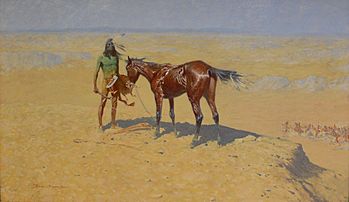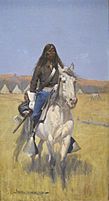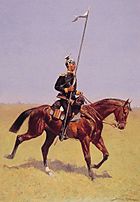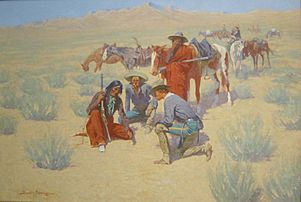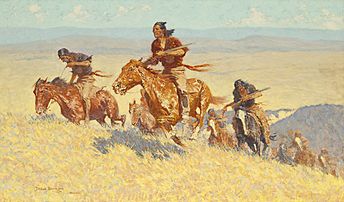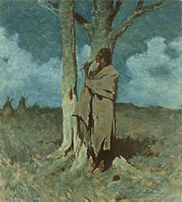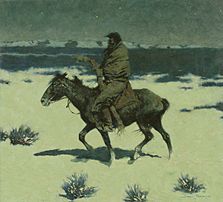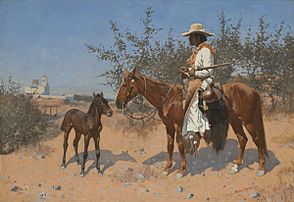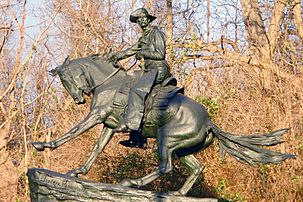Frederic Remington facts for kids
Quick facts for kids
Frederic Remington
|
|
|---|---|
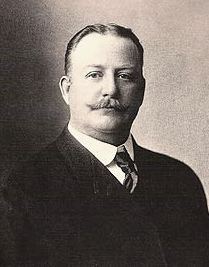 |
|
| Born |
Frederic Sackrider Remington
October 4, 1861 |
| Died | December 26, 1909 (aged 48) |
| Nationality | American |
| Education | Yale University, New Haven, Connecticut, one drawing class, 1878; Art Students League, New York, 1886 |
| Known for | Painting (watercolor and oil), sculpture, drawing (pen and ink, ink wash), mixed media, journalist and writer |
| Movement | Illustration, Impressionism, Nocturne, and Tonalism |
| Spouse(s) | Eva Caten (1884–1909) |
| Awards | 1891: Elected Associate of the National Academy of Design (ANA) |
| Patron(s) | Theodore Roosevelt, Elizabeth Custer, Harper's Weekly, Harper's Monthly, Century Magazine, Scribner's, Cosmopolitan, Collier's, and many others |
Frederic Sackrider Remington (born October 4, 1861 – died December 26, 1909) was a famous American artist. He was a painter, illustrator, sculptor, and writer. Remington was best known for his art that showed the Western United States in the late 1800s. His works often featured cowboys, American Indians, and the US Cavalry. He helped shape how people imagined the "Wild West."
Contents
Early life and art beginnings
Frederic Remington was born in Canton, New York, in 1861. His parents were Seth Pierrepont Remington and Clarissa Bascom Sackrider. His father was a colonel in the American Civil War and later a newspaper editor. Frederic's family loved horses, and some of his ancestors were saddle makers. His family also had relatives who fought in early American wars.
Frederic was related to Eliphalet Remington, who started the Remington Arms Company, a well-known gun maker. He was also connected to famous mountain men like Jedediah Smith. Through his mother's side, he was even related to George Washington, the first US president!
As a child, Frederic was active and strong. He loved to hunt, swim, ride horses, and go camping. He wasn't great at school, especially math, but he started drawing soldiers and cowboys at a young age.
When he was 11, his family moved to Ogdensburg, New York. He went to a military school where he took his first drawing lessons. His classmates found him friendly and good-humored, but not really soldier material. He enjoyed drawing funny pictures of his friends. At 17, he thought he might become a journalist and do art on the side.
Remington later went to Yale University to study art. But he found football and boxing more interesting than drawing still life objects. He liked drawing action scenes best. His first published drawing was a cartoon of a "bandaged football player" for the student newspaper. He left Yale in 1879 to care for his sick father, who died a year later.
After his father's death, Remington tried different jobs. He also made his first trip out West when he was 19. He went to Montana, hoping to buy a cattle ranch or a mining business. He didn't have enough money, but he saw the vast prairies, the shrinking bison herds, and the last big fights between the US Cavalry and Native American tribes. These scenes, which he had imagined since childhood, deeply inspired him.

Harper's Weekly magazine printed his first commercial drawing from this trip. In 1883, he tried sheep ranching in Kansas, investing all his inheritance. But he found ranching tough and boring, so he sold his land in 1884.
Remington kept sketching, but his drawings were still simple. He tried a hardware business and then became a part-owner of a saloon in Kansas City. He married Eva Caten in 1884, but she didn't like his saloon life and left him. With his wife gone and his business failing, Remington started drawing and painting seriously. He even traded his sketches for things he needed.
He soon had enough success selling his paintings to locals that he saw art as a real job. He reunited with his wife and moved to Brooklyn. He studied at the Art Students League of New York, which greatly improved his skills. It was a good time for him because newspapers were very interested in stories about the American West. He sent his Western-themed drawings to magazines like Collier's and Harper's Weekly. His first full-page cover appeared in Harper's Weekly in 1886. With help from his uncle, Remington could focus on his art career and support his wife.
Some of his relatives were also artists, including George Catlin, who painted Indian portraits, and Earl W. Bascom, a cowboy sculptor.
Becoming a famous artist
In 1886, Harper's Weekly sent Remington to Arizona to draw scenes from the government's fight against Geronimo, a famous Apache leader. He didn't find Geronimo, but he collected many real items to use in his paintings later. He also took photos and made sketches, noting the true colors of the West. Even though he used real observations, some art critics thought his colors looked "primitive."
After returning East, Remington covered the 1886 Charleston earthquake for Harper's Weekly. He also started drawing for Outing magazine. His first year as a professional artist was very successful, earning him good money. He realized he had found his life's work.
For magazines, he made ink and wash drawings, which could be easily printed in black and white. As he started using watercolors, he also sold his work in art shows. His paintings sold well, but he didn't win many awards yet, as there were many great artists at the time. A trip to Canada in 1887 led to illustrations of the Blackfoot and Crow Nation tribes, and the Canadian Mounties, which readers loved.
Later that year, Remington got a big job: to create 83 illustrations for a book by Theodore Roosevelt called Ranch Life and the Hunting Trail. This project greatly helped Remington's career and started a long friendship with Roosevelt.
His full-color oil painting Return of the Blackfoot War Party was shown at the National Academy of Design. The New York Herald newspaper said that Remington would "one day be listed among our great American painters." In 1889, he won a medal at the Paris Exposition, showing he was becoming a leading Western artist.
Around this time, Harper's Weekly promoted Remington heavily, saying he "draws what he knows, and he knows what he draws." This helped make him as famous as other top illustrators of the time.
His first solo art show in 1890 was very popular. Remington became well-known in society. His "cowboy" way of speaking and his "Wild West" reputation made him a popular person. However, attending many social events led him to eat and drink a lot, and he started gaining a lot of weight.
In 1890, Remington and his wife moved to New Rochelle, New York. They wanted more space for living and for his art studio. The town was close to New York City, which was good for his work, but also rural enough for him to ride horses and stay active. Many other artists and writers lived there too. Remington called his home Endion, an Ojibwa word meaning "the place where I live." He later built a special studio addition to his house.
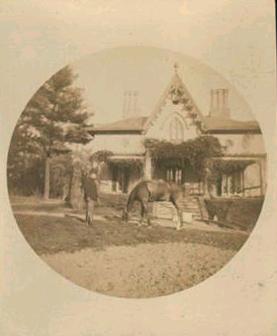
Later career and new art forms
Remington's fame made him popular with Western Army officers. They invited him to draw their portraits and help them get public attention through his articles and illustrations for Harper's Weekly. In return, Remington got special access to soldiers and their stories, which boosted his reputation as "The Soldier Artist." One of his paintings from 1889 shows cavalrymen in an Arizona sandstorm. He wrote that the "heat was awful and the dust rose in clouds."
Remington arrived just after the 1890 massacre at Wounded Knee in South Dakota, where many Sioux, mostly women and children, were killed. He reported on the event, describing the Army's actions as "heroic."
His painting Self-Portrait on a Horse (1890) shows how he wished he looked: a tough, lean cowboy. This was the image his publishers also worked hard to maintain.
In the 1890s, Remington often traveled around the US, Mexico, and other countries to get ideas. But his military and cowboy subjects always sold the best, even as the Old West was changing. He worked with Owen Wister, who became a leading writer of Western stories. Remington said, "My drawing is done entirely from memory. I never use a camera now." He focused on outdoor action and rarely showed scenes in gambling halls or dance halls.
Remington also started making sculptures. In 1895, with help from a sculptor friend, he created his first sculpture: a "broncho buster" (a cowboy breaking in a wild horse) on a horse rearing on its hind legs. This was a very difficult subject for a beginner. After several months, he succeeded, and bronze copies were sold at Tiffany's. He was very excited about this new type of art.
During this busy time, Remington also invented a new type of ammunition carrier, but the War Department didn't use it. He was getting tired of routine illustration and wanted to be a war correspondent, hoping for new subjects and the excitement of battle.
Remington kept in touch with famous people and politicians, including Theodore Roosevelt, who was then the New York City Police Commissioner. Roosevelt greatly admired Remington's work.
In Cuba and the Spanish-American War
Remington's connection with Roosevelt helped him get hired as a war correspondent and illustrator for William Randolph Hearst's New York Journal in 1897. He was sent to Cuba with journalist Richard Harding Davis. At first, Cuba seemed peaceful, and there was nothing to report. This led to a famous story (which might not be true) about telegrams between Remington and Hearst:
- "Everything is quiet. There is no trouble. There will be no war. I wish to return."
- "Please remain. You furnish the pictures and I'll furnish the war."
Remington returned home, but later, the USS Maine exploded, leading to the Spanish–American War. Remington went back to Cuba to see military action for the first time. It was a very difficult experience for him. He saw the Battle of San Juan Hill, where American forces, including those led by Roosevelt, fought. The real horrors of jungle fighting and camp life shattered his idea of war as heroic. His reports and illustrations focused on the soldiers, not just the generals.
When Roosevelt's "Rough Riders" returned to the US, they gave him Remington's bronze statue, The Bronco Buster. Remington said it was "the greatest compliment I ever had."
After 1900
In 1898, two of Remington's paintings were used on US Postal stamps, a great honor. In 1900, Harper's stopped using Remington as their main artist. To make up for this, Remington wrote and illustrated a novel called The Way of an Indian, which was published in Cosmopolitan magazine.
Remington then returned to sculpture, using a better method called lost wax casting. By 1901, Collier's was regularly buying his illustrations. As his art style grew, Remington showed his subjects in different types of light. His night paintings, which were very popular later in his life, like A Taint on the Wind and Fired On, used more Impressionism and focused on unseen dangers.
In 1902, he finished another novel, John Ermine of the Yellowstone, but it wasn't as popular as The Virginian by his friend Owen Wister. After this, Remington decided he would soon stop writing and illustrating to focus on sculpture and painting.
In 1903, Remington painted His First Lesson, showing a scene on a ranch in Mexico. He wanted his audience to "take away something to think about – to imagine." In 1905, Collier's magazine dedicated an entire issue to his latest works. That same year, he was asked to create a large sculpture of a cowboy for Fairmount Park in Philadelphia. This sculpture, called Cowboy (1908), was his only large-scale bronze and one of the first examples of art made specifically for a certain outdoor location in the US.
Near the end of his life, Remington moved to Ridgefield, Connecticut. In his last two years, he was influenced by The Ten, a group of artists who used Impressionism. He wished he could paint outdoors more, but his health was declining.
Frederic Remington died on December 26, 1909, after surgery for appendicitis. His large size made the surgery more difficult.
His home, the Frederic Remington House, became a National Historic Landmark in 1965. In 2009, the Post Office in Ogdensburg, New York was renamed the Frederic Remington Post Office Building in his honor.
Style and influence
Remington was the most successful Western illustrator during the "Golden Age" of illustration around 1900. Other Western artists were even called members of the "School of Remington." His art style was realistic, sometimes with an impressionistic touch. He focused on the people and animals of the West, mostly men, and the landscape was usually less important. He often took artistic liberties to make his depictions more exciting for readers.
His work with Owen Wister on "The Evolution of the Cowpuncher" helped create the idea of the "mythical cowboy" in American stories. This led to many Western books, movies, and plays.
Remington was one of the first American artists to correctly show how a horse moves when galloping. Before him, horses in full gallop were often drawn with all four legs stretched out, like "hobby horses." Remington's galloping horses became his signature, and many artists copied his accurate way of showing horse motion. He believed that an artist needed to know more than a camera and could slightly exaggerate natural motion for the best visual effect.
Remington also invented "cowboy" sculpture. His first piece, The Broncho Buster (1895), started an art form that is still very popular today. He is known as the "Father of Cowboy Sculpture."
Remington was also a smart businessman. He made sure his original artworks were handled carefully so he could sell them. He kept detailed notes about his works and sales. In 1991, a documentary about his life, Frederic Remington: The Truth of Other Days, was made for the PBS series American Masters.
Remington was played by Nick Chinlund in the TNT miniseries Rough Riders (1997), which showed his time as a war correspondent during the Spanish-American War.
Selected works
- Selected works
-
Coronado Sets Out to the North
-
Cowboy, 1908, in Fairmount Park, Philadelphia
The Song of Hiawatha illustrations
Collections
Many American museums have important collections of Frederic Remington's art, including:
- Frederic Remington Art Museum, Ogdensburg, New York
- Amon Carter Museum, Fort Worth, Texas
- Sid Richardson Museum, Fort Worth, Texas
- Buffalo Bill Historical Center, Cody, Wyoming
- Gilcrease Museum, Tulsa, Oklahoma
- Metropolitan Museum, New York City
- Museum of Fine Arts, Houston
- National Cowboy & Western Heritage Museum, Oklahoma City, Oklahoma
In the Utah Museum of Fine Arts (UMFA)
- Bronco Buster (1895) – Bronze Figurine
- The Sergeant (1904) – Bronze Bust
- Navajo Shepherd and Goats – Paper Engraving/Illustration
- The Mountain Man (1903) – Bronze/Marble Figurine
- Rattle Snake (surmoulage) – Bronze/Marble Figurine
Legacy
- The Frederic Remington Art Museum in Ogdensburg, New York, is dedicated to his work.
- Frederic Remington High School in Brainerd, Kansas, is named after him.
- His home, the Frederic Remington House in Ridgefield, Connecticut, is a National Historic Landmark.
- The Frederic Remington Post Office Building in Ogdensburg, New York, is named in his honor.
- A Liberty Ship used in World War II was named Frederic Remington.
- He is an inductee of the New Rochelle Walk of Fame and the Texas Trail of Fame.
- The Remington Arts Festival is held in Canton, New York, every October.
- He was inducted into the Society of Illustrators Hall of Fame in 1978.
- He was inducted into the Hall of Great Westerners of the National Cowboy & Western Heritage Museum in 1978.
See also
 In Spanish: Frederic Remington para niños
In Spanish: Frederic Remington para niños
- Cold Morning on the Range, a Remington painting
- Frederic Remington: The Truth of Other Days, a 1991 documentary
- Earl W. Bascom, cowboy sculptor and cousin to Remington
- J. K. Ralston, western artist
- Charles M. Russell, western artist


